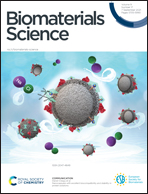Irisin recouples osteogenesis and osteoclastogenesis to protect wear-particle-induced osteolysis by suppressing oxidative stress and RANKL production†
Abstract
The disruption of bone homeostasis with the decrease in osteoblastic bone formation and facilitated osteoclastic bone resorption is the leading cause of periprosthetic osteolysis. Accumulative studies have indicated that irisin has the function of maintaining and rebalancing bone homeostasis. In this study, we explored the protective effect of irisin on wear-particle-induced osteolysis in mice. The results showed that irisin effectively inhibited titanium (Ti) particle-induced calvarial osteolysis, supported by a lower bone loss and existence of more collagen, compared with the ones stressed by Ti particles. Further analysis demonstrated that irisin not only rescued Ti-particle-impaired osteogenesis derived from bone mesenchymal stem cells (BMSCs) but also alleviated the increase in wear-particle-induced nuclear factor-κB ligand (RANKL) secreted by BMSCs-derived osteoblasts, which consequently restrained the activation of osteoclasts. Meanwhile, irisin inhibited osteoclastogenesis by the direct inactivation of reactive oxygen species (ROS) signaling. These results revealed that irisin functions to fight against osteolysis caused by wear particles through rebalancing the periprosthetic bone homeostasis microenvironment, which may provide a potential therapeutic strategy for the management of osteolysis and induced prosthetic loosening.



 Please wait while we load your content...
Please wait while we load your content...